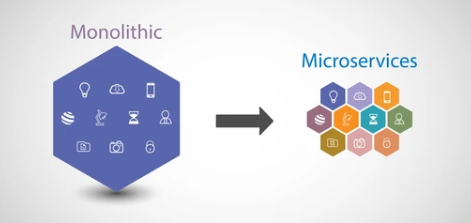Microservices Architecture: Is it Right for your business ?
 Hussain Rana
Hussain Rana
Introduction
Microservices are modular components that can be deployed and managed independently, representing an extreme form of modularization. For example, a social media platform implementing microservices architecture can be divided into the following modules.
Search:- Enables users to search for other users, posts, or specific content within the platform
Profile Management:- Handles user profile creation, editing, and personalization features.
Messaging:- Handles real-time messaging and communication between users.
News Feed:- Manages the generation and delivery of personalized news feeds for each user.
Deployment monolith vs Microservices
In deployment monolith, all modules are bundled together within a single application. Consequently, any modifications to a specific module can only be brought into production by bringing a new version of the entire application with all its modules into production. However, with microservices, changes to specific modules like Messaging feature can be made without affecting other modules.
Advantages, Challenges & Tradeoffs
Advantages
Enhanced Resilience: Microservices architecture improves resilience as failures in one service do not impact the overall system, resulting in increased fault tolerance.
Independent Scaling: Each microservice can be independently scaled, allowing for better resource utilization and handling increased workload.
Team Autonomy: Microservices architecture allows for decentralized development and deployment, giving teams more autonomy and ownership over their respective services. Teams can make decisions independently regarding domain logic and technology.
Continuous delivery: Microservices facilitates continuous delivery enabling frequent and automated deployments, ensuring faster time-to-market and better software quality.
Replacing Legacy Systems: Replaceability is a great strength of microservices architecture. It facilitates the gradual replacement of legacy systems by allowing organizations to rebuild and modernize individual services without impacting the entire system.
Security:- Microservices can be isolated, allowing for the introduction of firewalls in their communication. Communication between microservices can be encrypted to ensure authenticity and prevent corruption of other services in case of a hacked microservice.
Challenges
Operational Overhead:- With multiple services running independently, operational tasks such as monitoring, logging, scaling, and securing each service individually can add overhead and complexity to the operations team.
Increased Complexity:- Microservices architecture introduces additional complexity compared to monolithic architectures. Understanding the interactions between services, managing inter-service communication, and ensuring system-wide consistency requires careful design and ongoing maintenance.
Independently Deployable:- Independence in deployment is vital in microservices architecture. Dividing microservices into containers is necessary but insufficient. Implementing interface changes enables individual microservices to deploy independently, offering both new and old interfaces for seamless deployment.
Independent Testing:- Testing in microservices architecture requires independent execution. Testing all microservices together can be problematic if one service delays the process, affecting other deployments. This presents challenges. Additionally, the system's division into microservices increases the number of interfaces requiring testing.
Latency and failures:- Microservices rely on network communication, which introduces higher latency compared to local communication. Moreover, the probability of communication failures is also increased. A microservices system cannot rely on the availability of other microservices which contributes to the overall complexity of the system.
Tradeoffs
When implementing microservices, teams may compromise based on their objectives. For instance, for robustness, microservices are implemented as separate Docker containers, enabling independent crashes. However, if robustness is not critical, alternative approaches like running multiple microservices together as Java web applications in one server can be considered. Although not isolated in terms of robustness, they remain independently deployable. It's important to note that a memory leak in any microservice would cause all of them to fail. Nonetheless, such a solution may be easier to operate and thus offer a better trade-off in the long run.
Evaluating Business Needs
Understand Business Goals and Requirements: Begin by gaining a deep understanding of the business's goals, needs, and long-term objectives. Identify the specific requirements related to scalability, agility, flexibility, and integration.
Analyze System Complexity: Evaluate the complexity of the business domain and the underlying system. Consider factors such as the size of the application, the number of functionalities, and the interdependencies between different components.
Assess Scalability Needs: Determine whether the business anticipates significant growth in the future, requiring the ability to scale the application quickly and efficiently. Microservices architecture can provide better scalability compared to monolithic architecture.
Consider Development Team and Expertise: Assess the availability of skilled developers within the organization or the ability to hire experienced professionals. Microservices architecture may require a different skill set compared to traditional development approaches.
Evaluate Integration Requirements: Analyze the business's need for integrating with external systems, such as third-party services or legacy applications. Microservices architecture allows for easier integration due to its modular nature.
Examine Deployment and Release Cycles: Consider the business's release and deployment processes. If there is a need for independent deployment of specific features or modules, microservices architecture can provide the necessary flexibility.
Analyze Maintenance and Upgrades: Assess the business's ability to manage and maintain the application over time. Microservices architecture offers simplified maintenance as each service can be updated independently without impacting the entire system.
Consider Cost Implications: Evaluate the financial aspects of adopting microservices architecture. Assess factors such as initial development costs, infrastructure requirements, and ongoing maintenance expenses.
In conclusion, microservices offer several advantages such as enhanced resilience, independent scaling, team autonomy, and continuous delivery. However, they also come with some challenges. After evaluating business needs, the question we need to ask when making decisions is, 'Will it increase business value?' Careful consideration of tradeoffs and a thorough understanding of business goals are key to a successful implementation.
Subscribe to my newsletter
Read articles from Hussain Rana directly inside your inbox. Subscribe to the newsletter, and don't miss out.
Written by
